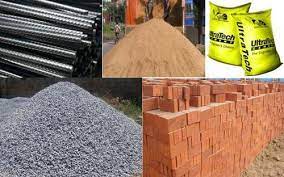Rising Material Cost And Its Impact on Construction

Introduction
Increasing building material costs are impacting project demand and revenues in the construction industry.
According to 65% of survey participants, high input costs had a negative effect on demand, whereas profits had a negative effect on demand for 70% of respondents. Higher labor costs are one aspect, but the majority of businesses have identified material costs as posing a bigger problem. According to the vast majority of respondents, the price of building supplies has increased by 10% or more during the past three months. This price increase comes after earlier ones.
As the saying goes, you need money to make money. The majority of the required investments for construction companies are made in labor and supplies. The profit margins are pinched and tightened as the costs of both rise.
The Labour Shortage
There are a lot of available opportunities in the construction business, but there aren’t enough suitable applicants to fill them. They are aware of the demand for talented candidates. As a result, several companies could have to fight for a candidate’s attention during the hiring process.
Due to the fact that many companies will use these bonuses to entice desired personnel, this results in higher compensation and benefits. In fact, 62% of the businesses questioned claim to actively engage in this in order to recruit or keep personnel.
This strategy may assist businesses in attracting and retaining the greatest talent, but it has a price. If labor costs keep going up, businesses will have to raise their prices, profit margins will be more squeezed, and the industry will undoubtedly have negative impacts.
Building costs have risen so quickly as a result that many households are encountering extraordinary disruptions. For instance, some respondents claimed that appraisers cannot support rising house prices with comparable properties, which is a worry for home builders across the nation. Some claim that suppliers are reluctant to lock in pricing for more than a week, if at all, which results in a great deal of uncertainty. The entire building industry has experienced severe upheaval as a result of the uncertainty and shifting prices. As unanticipated rises in material costs continue to clear the way, contractors are being compelled to submit much higher bids for projects.
Materials on Rise
The cost of materials is growing due to a variety of variables.Tariffs, trade conflicts, environmental laws, and changing customer preferences all result in higher costs. Many projects call for materials like iron, steel, lumber, and steel, all of which have suffered sharp price rises recently. The price of crude oil increased by 49%, that of lumber by 29%, and that of iron and steel by 14% in just one year.
As a result, the overall cost of projects increased by more than 5% in just 2018 alone. This growth may reach 10% in some areas, such as the Bay Area.
While some businesses collaborate extensively with contractors to save costs during the pre-development phase, prices are changing so quickly that once the project begins, their predictions may be wholly inaccurate.
The increase in material costs is forcing developers to reevaluate whether or not to begin upcoming residential and commercial construction projects. Bart Oosterveld, director of the Atlantic Council’s global business and economic programme, claims that if tariffs are kept in place, they will have an impact on a number of industries and prices, including those for cars, appliances, and e-commerce.
Because of their negotiating position, larger developers will find it easier to obtain a steady supply of steel at a reasonable price. It’s possible that smaller developers won’t have as much negotiating power as bigger developers and won’t be able to pass on cost hikes to their clients. In order to compete with larger organisations that have access to more capital, it is important for smaller contractors to be able to provide their potential clients with equivalent services. Smaller companies will find it difficult to obtain larger bids in the current market without this kind of material leverage, which might raise their annual revenue and help them grow their company.
You would think that with unemployment at a record high and the number of open positions at a record high, the two would balance each other out. However, we haven’t seen a clear shift in the hiring market, which has harmed the expansion of the construction industry in 2021. Many businesses are currently at a full standstill in terms of their potential for expansion due to supply and employee shortages.
Price Hike
Once there is some certainty on demand following Omicron-induced disruptions, a price increase at the end-user level is projected to take effect towards the latter part of 2022. Developers are hesitant to spike demand right away.
Omega and upward The country’s Covid instances have already resulted in some supply bottlenecks, problems with labor availability in some micro markets, and a decrease in buyer inquiries at the site-level. The infection hasn’t yet had a noticeable effect on sales, though.
On the other hand, since January to March 2020, the price of steel has increased by 45–47% to about 62,300/MT; the price of copper has increased by 70–75% to about 745,000/MT; the price of aluminum has increased by 55–50% to about 203,385/MT; the price of PVC products has increased by 80–90% to about 165,000/MT; and the price of fuel/diesel has increased by more than 43% to 94/liter.
Contractors are raising their overhead costs in response to the market uncertainties.
The Covid-19 protocols’ cascading effects and related expenses are to blame for the increase in labour costs, which is about 10 and 15 percent year over year. This includes expenses for adhering to new protocols, such as RT-PCR tests, waiting for test results, providing extra room for the same amount of labor, maintaining a quarantine facility, and taking sanitation precautions. There are also incurred labor retention and transportation expenses.
According to a recent report by consulting giant JLL, while construction costs per square foot increased for both new and existing projects at a similar rate of 105%, costs for new projects increased significantly, rising from 105% in the third quarter of 2020 to 1130% in the fourth quarter of 2021, or an increase of 8%.
“While markets remain erratic, it is projected that building prices would stabilize by Q2-Q3 of the calendar year 2022 (April to September). The research stated that the supply chain failure (following the second wave) is the main cause of the price increase that we have seen.
Availability Issues Affect Everyone
A record number of manufacturers of building materials have announced price increases due to supply problems. A shortage of goods is anticipated during the next 12 months as a result of supply chain delays, a dearth of easily accessible shipping containers, and a decrease in port staff. The Construction Products Association (CPA) is the most recent organization to express alarm about this situation, which could have long-term effects for the construction industry and all fixed-price contracting firms.
According to the CPA’s most recent State of Trade research, over 97% of businesses that deal with commodities like steel, concrete, and heavy side products like lumber anticipate that prices will remain high in the upcoming year. Since the study’s inception in 2011, this represents the highest level of participation.
The same survey found that 92% of businesses that deal with minor products like insulation, fit-out materials, and glass anticipate price increases in the upcoming year. Almost all of the businesses that responded to the survey claimed that total costs had increased in the year prior and would do so again in the following year.
Compared to 61% and 6% in the fourth quarter of 2020, 82% of light side manufacturers and 77% of heavy side manufacturers, respectively, agreed that prices increased in the first quarter of 2021. These numbers show that material costs around the world are declining.
Building costs have increased as a result of the expanding global oil market, which was declining in 2020. According to 73% of heavy side enterprises and 51% of light side businesses, energy prices have increased as oil prices throughout the world have rebounded. Additionally, in the first quarter, 48% of light side businesses and 50% of heavy side businesses also reported salary increases.
According to the CPA survey, logistics issues were also cited as a factor in raw material shortages. These factors prevented the sales increase of 40% of light side manufacturers and roughly 33% of heavy side manufacturers. In the survey’s history, this is the highest proportion ever reported.
Iron ore’s price has nearly doubled in recent months, while sawn wood’s price has climbed by 30%, copper’s price has increased by 49%, aluminum’s price has increased by 23%, and gravel, clay, and sand’s price has increased by 20%. These figures highlight the problem of growing material costs, which, together with uncertainty regarding the supply of materials, may harm the construction sector as it recovers from the shutdown.
A survey by IHS/CIPS found that the industry’s raw material delivery times have gotten longer, with 41% of respondents reporting longer delivery times from suppliers in March. The CLC warns that shortages will undoubtedly get worse in the upcoming months and advises businesses to plan for longer wait times. According to Core Five, contractors should be prepared for a “perfect storm” of delays and price increases in the upcoming months due to post-Brexit trading laws, COVID-related logistical issues, and globally rising oil prices.
For costs that are passed on to customers, there are fees:
The majority of respondents claimed they informed their customers of increases in material costs. For instance, 66% of respondents said they raised consumer costs in a similar range to those who said their price increases ranged from 10% to 25%. But some people left behind less, while others left behind more.
As the hike in material prices was not initially estimated and incorporated in contracts signed in 2020 with start dates in 2021, several contractors who signed contracts last year before the surge in material prices took place have found themselves in a major and unexpected bind.
Those that overcharged customers for materials did not participate in the survey. But since escalation clauses can’t be used, it’s plausible that some businesses are raising prices in anticipation of future rises in material costs.
As material costs continue to climb, further tariffs will continue to have an impact on businesses and a number of industries nationwide. Everyone is worried about project delays and budget overruns, but there are also millions of individuals whose employment is at jeopardy due to rising material costs.
Fortunately, there are several ways to help lower material and labor costs inside the building envelope as material prices continue to climb. Panelization can help conserve materials and reduce waste, design can be tuned and improved to use less material, and technology is constantly advancing and supporting in the development of new creative solutions. Only a small number of innovative concepts, such as design optimization, controlled manufacturing, and technology advancement, are making a difference in the building industry and reducing the cost of materials.
Solutions
There are numerous strategies to deal with the rising costs in the construction sector, but each region and expertise will require a unique response.
Working directly with technology is one option, though. Even if some technological developments might demand a time, money, and training commitment, those expenses may be more than made up for in the long run by efficiency and safety. Software for building information modeling (BIM) can, among other things, save expenses and assist the project stay on schedule. Drones can keep work locations safer by keeping an eye out for potential threats or hazards.
You can work with our knowledgeable team of consultants to locate and attract the best employees in order to address the talent shortage. The typical talent hunt is time-consuming, expensive, and tiring. We can discover the ideal applicant for your project and assist in reducing those costs.



